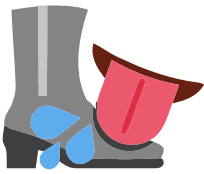If you havent before, have a look over the chicargo street medics handbook, there's some good info on pepper spray decontamination (though I'd avoid using anything but water to flush eyes)
also, avoid wearing makeup and contact lenses to events like this, tell your comrades
https://mutualaiddisasterrelief.org/wp-content/uploads/2020/04/kupdf.net_street-medic-handbook.pdf
First aid: When approaching people who have been ex- posed to chemical weapons, take a moment to call out “Who here has been sprayed?” People who are clearly making eye contact or who respond, “ooh, ooh me!” may not be your first priority. Re- member it is often the people who are unable to seek care that need it most. Once you’ve approached someone who has been pepper sprayed:
- Introduce yourself and get consent. Remem- ber the patient may be blinded and enraged.
- Immediately ask if the patient has asthma or is wearing contacts.
- Encourage calm and steady deep breathing. This will lessen panic.
- Move patient to an uncontaminated area if there is gas in the air. Ask for consent, then put hands on patient and guide them.
- Encourage coughing and spitting so he doesn’t swallow the chemicals.
- Calm, comfort, reassure, and educate about how the pain is temporary and we are extremely strong, and about the importance of decontamination before entering buildings. The most intense and painful symptoms are temporary and will go away within about 30 minutes with no treatment.
- Flush eyes with water, saline, salt water, or liquid antacid with water (LAW). Our LAW 52 recipe is 50% Maalox brand liquid antacid and 50% water. Put it in a squirt top water bottle. In the US we recommend Maalox because we know what the ingredients are. They may vary in other countries. Active ingredients to look for are magnesium hydroxide and sodium hydroxide. The anti-gas ingredient simethicone is not known to be dangerous or helpful. Alcohol, which some antacids contain, is bad for the eyes. Sorbitol, which is sugar alcohol, does not seem to cause harm. We recommend Maalox brand unflavored for best results, though some generics work as well. To flush eyes:
- Get patient lower than you – kneeling, sitting, or hunched over.
- Tilt head forward and to the side you are go- ing to flush.
- Hold eyes open for patient if you need to.
- Flush from the inside corner of the eye to the outside – be careful to not let it (and the chemicals it is moving) run across the face/into the other eye.
- Tilt head the other way and repeat flushing the other eye. You can also squirt LAW into patient’s mouth, have them swirl it around, and then spit it out.
RED FLAGS • Patient leaves the chemical weapons area and does not quickly breathe more easily. • Patient does not respond to care. • Unusual symptoms that do not quickly improve.
Decontamination
Avoid entering enclosed spaces (like your house) with contaminated clothing, and be aware of vul- nerable people who you might expose. • Take clothes off outside and put them into a plastic bag. Seal it and do not open until do- ing laundry. • Avoid touching anything (pets, furniture, car, phone, etc) until you have washed up. • Take a tepid shower – heat will irritate a new burn. Do not use soap that has peppermint in it: this will further irritate skin that has been exposed to chemicals. • Wash clothes immediately with detergents, several times if need be.




